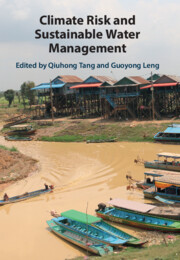Book contents
- Climate Risk and Sustainable Water Management
- Climate Risk and Sustainable Water Management
- Copyright page
- Contents
- Contributors
- Preface
- Acknowledgements
- Part I Water-Related Risks under Climate Change
- Part II Climate Risk to Human and Natural Systems
- Part III Sustainable Water Management under Future Uncertainty
- 15 Managing Urban Flood Risk and Building Resilience in a Changing Climate
- 16 Soft Computing Methods and Water Management
- 17 Rainwater Harvesting for Sustainable Water Resource Management under Climate Change
- 18 Variability of Runoff Coefficient and Precipitation Elasticity at Watersheds across China
- 19 Contribution of Hydrological Model Calibration Uncertainty to Future Hydrological Projections over Various Temporal Scales
- 20 Future Water Scarcity over the Yellow River Basin and the Effects of Adaptive Measures
- 21 Shrinking Lake Urmia
- Index
- References
15 - Managing Urban Flood Risk and Building Resilience in a Changing Climate
from Part III - Sustainable Water Management under Future Uncertainty
Published online by Cambridge University Press: 17 March 2022
- Climate Risk and Sustainable Water Management
- Climate Risk and Sustainable Water Management
- Copyright page
- Contents
- Contributors
- Preface
- Acknowledgements
- Part I Water-Related Risks under Climate Change
- Part II Climate Risk to Human and Natural Systems
- Part III Sustainable Water Management under Future Uncertainty
- 15 Managing Urban Flood Risk and Building Resilience in a Changing Climate
- 16 Soft Computing Methods and Water Management
- 17 Rainwater Harvesting for Sustainable Water Resource Management under Climate Change
- 18 Variability of Runoff Coefficient and Precipitation Elasticity at Watersheds across China
- 19 Contribution of Hydrological Model Calibration Uncertainty to Future Hydrological Projections over Various Temporal Scales
- 20 Future Water Scarcity over the Yellow River Basin and the Effects of Adaptive Measures
- 21 Shrinking Lake Urmia
- Index
- References
Summary
Urban flooding disasters have increased due to climate change in recent decades. The induced casualties and economic losses are aggravated by intense urbanization. Climate change projections present high confidence in the increase of flood hazard in the future of the twenty-first century. Moreover, population growth and socio-economic development may lead to an increase of vulnerability to flood hazard. In this context, most countries have launched relevant initiatives to mitigate and adapt to urban flooding disaster, in order to improve urban resilience to flood disaster and achieve urban sustainable development goals. Structural, semi-structural and non-structural strategies have been developed and evaluated in the framework of flood risk management. Furthermore, the integrated flood modelling framework has been developed to support the integrated flood risk assessment under a changing environment. Based on projections, urban flood resilience can be estimated and applied to improve the decision-making of flood policy and regulation, and to guide the planning and design of the flood risk management strategy. In this context, this chapter reviews and discusses the natural and anthropogenic drivers of urban flooding, flood risk management in developing and developed countries and the integrated modelling framework of flood risk management.
Keywords
- Type
- Chapter
- Information
- Climate Risk and Sustainable Water Management , pp. 315 - 341Publisher: Cambridge University PressPrint publication year: 2022

